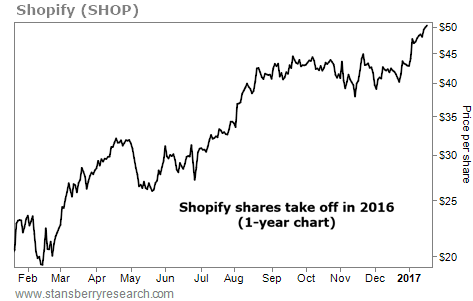| Home | About Us | Resources | Archive | Free Reports | Market Window |
Three Clues to Finding the Next 100-BaggerBy
Friday, January 20, 2017
I get one question from readers over and over again...
Why invest in stocks if the world is going to pot?
I'm going to cite one piece of remarkable evidence I uncovered in my own massive study of the stock market's biggest winners.
I call these winners "100-baggers" (stocks that returned 100-to-1). And after spending three years and $138,000 to investigate them, I discovered they all have certain features in common.
As for the world going to pot, let's agree that there is plenty to worry about. And the stock market is not cheap.
The S&P 500's "CAPE" ratio (a stock valuation measure designed to smooth out earnings volatility) has only been this high or higher three times in the last century – right before the crashes of 1929, 2000, and 2007. That means many stocks are expensive.
But just because a stock market index like the S&P 500 is pricey doesn't mean there aren't good values out there. Unless you're a buyer of the index itself, it is not relevant to the business of finding great stocks today.
Let me give you a historical example...
The 17-year stretch from 1966 to 1982 was dead money for stocks – or so many people would have you believe. The Dow Jones Industrial Average basically went nowhere. And if you factor in the period's high inflation, the performance was even worse. Based on this, you might think that you didn't want to be in stocks at that time.
But here's what my research on 100-baggers found: There were 187 stocks you could've bought between 1966 and 1982 that would have multiplied your money 100 times.
In fact, during that 17-year stretch, you'd have had at least a dozen opportunities each month to multiply your money 100 times if you just held on.
In some cases, you didn't even have to wait very long. Southwest Airlines (LUV) returned more than 100 times in about 10 years beginning in 1971. Leslie Wexner's L Brands (LB), owner of Victoria's Secret, did it in about eight years starting in 1978. In 1966, you could've bought H&R Block (HRB) and turned a $10,000 investment into $1 million in less than two decades.
So the indexes can tell you what kind of environment you are in. But they don't predict what will happen to individual stocks.
It's certainly harder to find great opportunities in highly priced markets. And it's easier to find big winners at market bottoms (but perhaps not so easy to make yourself buy them, as fear is rife at such times). These facts should surprise no one.
Southwest Airlines, L Brands, and H&R Block had something in common...
See the pattern here? All three were small companies with lots of room to grow.
For larger companies, the condition of the economy can be a constraint. They depend on broad-based economic growth. It is hard for Coca-Cola (KO) or McDonald's (MCD) to grow faster than the overall economy because they're already so big.
It's really just a matter of scale.
McDonald's did about $25 billion in sales in 2015. To double that number, it would have needed to sell an extra 5 billion Big Macs the next year. Granted, this is an oversimplified example, but you get the idea.
But it's not as hard for a small company to increase its sales by double, triple, or more.
Not all small companies become big companies, of course. But after studying more than 360 companies that have become 100-baggers, I have a few basic clues to look for...
Think about the three big winners above. You had a small tax preparer, an airline, and a retailer. All three started as local, or regional, businesses. And all three grew into national brands. To get those big returns, even in lousy economic environments, you need to have room to grow.
If you invest $100 in a business and it generates a cash profit of $20, that's a 20% return on equity, or "ROE." You don't need to know a lot about finance to know that is a very good return. Nearly all of the stocks in my 100-bagger study were good businesses by this measure. They earned returns of 20% or more.
H&R Block, for example, earned astronomical returns on its equity – especially in the early days. Its ROE was more than 30% in most years. For L Brands, ROE was over 25% for years and years. And low-cost Southwest Airlines had – and still has – among the best economics of any airline.
Which brings me to the final – and perhaps most important – clue I'll share with you today...
This one is just math. If you can earn 30% on your equity and reinvest your profits and earn 30% again... well, the dollars start to pile up really fast.
After 10 years, you'll have 14 times what you started with. After about 18 years, you'll have a 100-bagger. This is how you power through bad economic times. Finally, there is a great Charlie Munger quote I want to share because it shows the importance of this concept of ROE...
So there you have it. Even though the overall market looks expensive, remember that you are not buying the market. You're buying individual stocks. That's why you should look for great small-cap stocks with the traits I've shared above.
If you find a business that can earn 25% or so on its capital over many years, what happens to the overall market won't matter.
Sincerely,
Further Reading:
"The idea of 'stocks' is something that exists in our heads," Chris wrote recently. "Nobody owns stocks. They own individual companies." Even when bargains are hard to find, beating the market may be easier than you think. Learn more here: Why I Don't Focus on the Overall Market.
From 1978 to 2012, one ordinary investor grew his account from $200,000 to an incredible $6.6 million. How did he do it? Learn the controversial secret in Chris' recent essay: How to Become a Millionaire Using Other People's Money.
Market NotesA NOTABLE CALL ON THIS TECH STARTUP Today's chart shows the rapid rise of an e-commerce powerhouse...
We're talking about Shopify (SHOP). The Canadian firm makes it easy for businesses to sell their products online using its cloud-based software. Basically, anyone with Internet access and something to sell can use Shopify's services. The company serves more than 325,000 businesses in about 150 countries... including Tesla Motors and Red Bull, among others.
Porter and his research team recommended shares of Shopify last April. They praised the company's easy and affordable services... its scalable business model... and its huge growth potential.
Back then, Shopify shares traded at less than $30. Nine months later, they're trading for around $50... and they continue to hit new highs almost every day. The future looks bright for Shopify...
 |
Recent Articles
|



